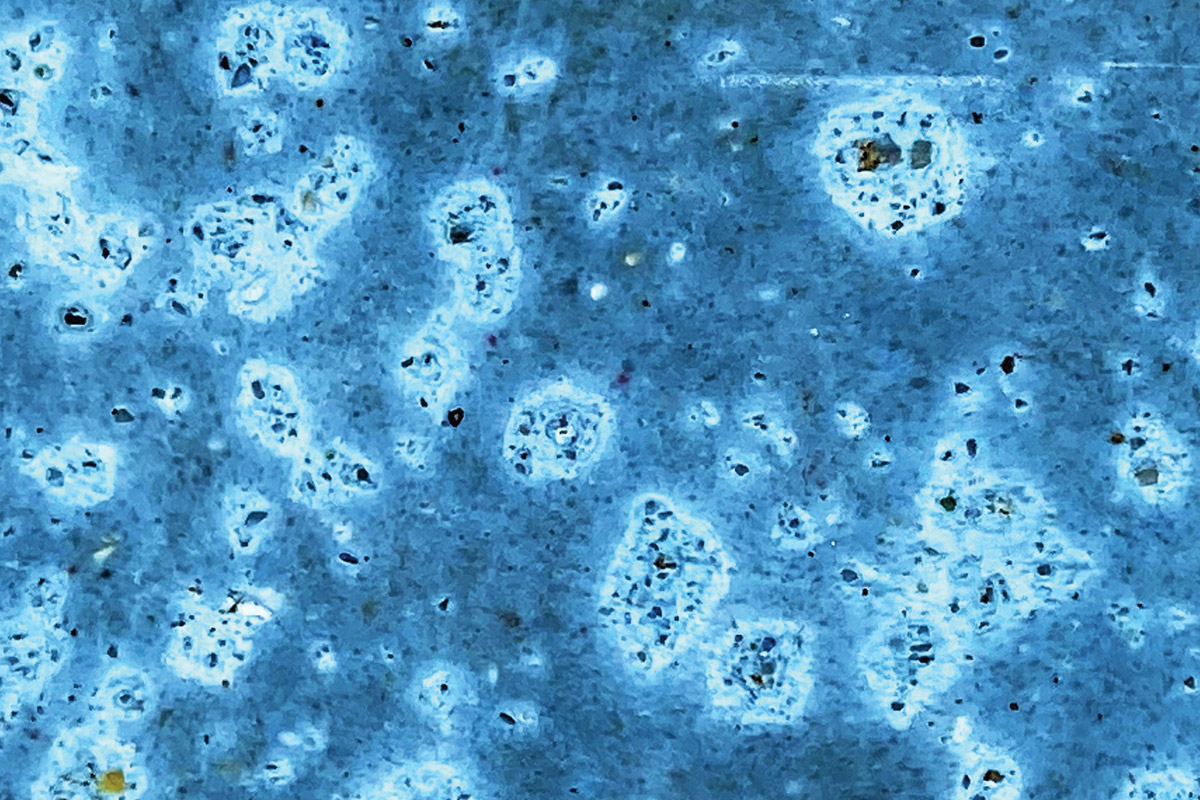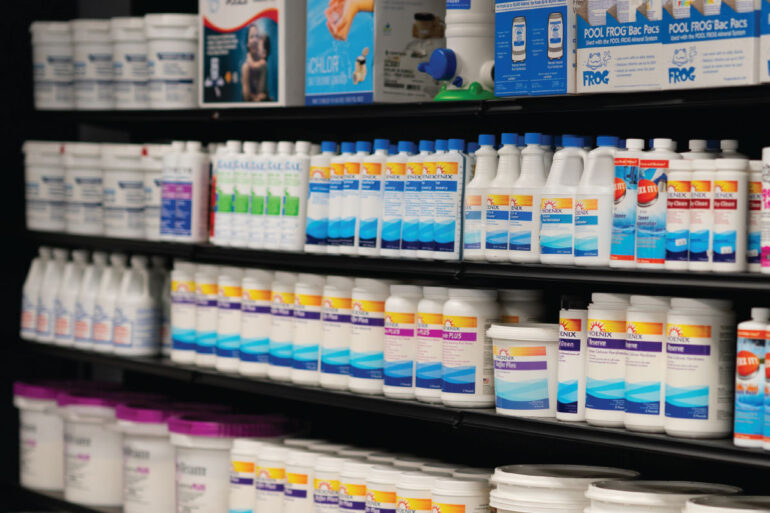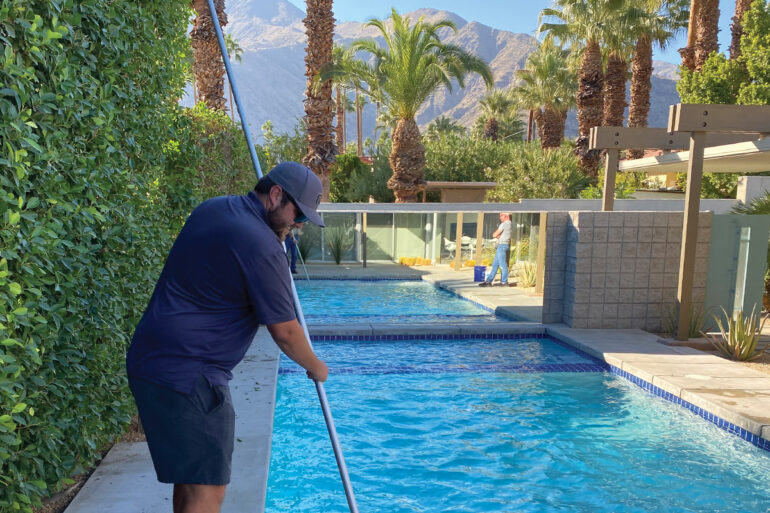A Fight to the Finish

Identifying common pool finish plaster problems
Attention to details can often eliminate many problems that commonly plague pool finishes. Identifying, preventing, solving and clearly communicating these issues both during installation and maintenance set the top pool professionals apart from the rest.
Here are some common finish problems pool professionals might run into.
Discoloration
There are many possible reasons for stains or discolorations in a pool’s finish. Organic matter, such as leaves, nuts and berries can temporarily stain a pool surface, but they usually go away over time, according to Mark Thompson, owner of Absolute Pool & Spa Care in Cumming, Georgia. However, other stains are not so easy.
An over-abundance of minerals, like iron, magnesium or copper can also stain a pool’s surface. Sometimes, this issue stems back to the chemicals used in the water, Thompson says. Good water management can prevent many of these stains.
Other times, discoloration comes from inorganic matter — such as a screw or other piece of metal — that falls into a pool and is not immediately removed. Malfunctioning equipment can also lead to staining. For example, a deteriorating water heater can cause copper staining as the copper tubing disintegrates into the water supply.
When staining is detected, testing the water for these minerals and chemicals is the first step to identifying the culprit and fixing the problem, Thompson says.
In some cases, acid washing may remove the stain, but this procedure is not a cure-all for pool problems, warns Kent Westfall, director of technical services for the National Plasterers Council.
“It does brighten up the color and take away the discoloration,” he says. “But if it’s done incorrectly or too early, the problem can come back. So, acid washing is not always the answer.”
Additionally, draining and acid washing a pool is expensive, especially in dry climates where the cost of water is high. Some companies offer what are known as no-drain acid washes, wherein the pH and alkalinity are lowered to a point of being corrosive, allowing the water to slowly eat away at soft materials like stains and scale, over a three-day period.
Poor consolidation or compaction
Some problems stem back to pool installation, such as poor consolidation. Improper consolidation is what happens when air bubbles are not properly pushed out of the plaster when it is being applied, leading to permanent, unattractive bumps on the finished surface.
“If you don’t pass the trowel over [the finish] with enough pressure or enough times, you can end up with that air bubble,” Westfall says. “That’s a consolidation issue. It’s a troweling error.”
Compaction of the pebbles in an aggregate finish is another installation procedure that should be done with care, as it affects the look and life of a pool. If the pebbles are compacted too closely, there may not be enough cement to hold it together long term. If the compaction is too loose, with too much concrete, it can diminish the visual appeal of the pool because the pebbles are less noticeable.
“When you do an exposed aggregate finish, it’s as much of an art as it is a science, and it takes time to become a good finisher,” Westfall says. “It’s not as easy as everybody thinks. If you see somebody who’s really good at what they do, they make it look easy. It takes time to develop that skill and the knowledge of how the cement reacts. So, if you’re going to get involved in it, you have to be willing to put in the time and the hard work to learn all of the little intricacies of installing a finish.”
In Westfall’s experience, these issues happen most often when the installation crews are rushing on tight schedules or have not been fully trained.
Pigmentation problems
Color choices for pools have increased significantly over the years, which makes it important to ensure pigments are mixed properly. If pigments are not fully mixed, it may become apparent in small streaks of color that appear when the finish is applied. As the trowel goes across the pigment, it pulls some of the color across the finish that has not been fully mixed. Inconsistent mixing can mean inconsistent coloring in the pool as well.
If caught early in the installation process, these erroneous pieces can be dug out and replaced, but not after the pool is set, Westfall says.
Westfall highly encourages pool installers to fully follow manufacturer recommendations for mixing pigments.
“There’s a precise method to mixing,” he says. “You do not get a homogenous mix if you cut down on the length of mixing that’s required or the order in which the materials are placed.”
Sometimes, during the life of a pool, the finish colors appear to fade. This could simply be pigment masking — when scale buildup covers the colors. In this case, simply removing the scale will bring back the color, Westfall says.
A more serious issue, though, is pigment depletion. This happens when corrosive water begins to etch the surface of the pool. As it eats away the cement, it removes the color, as well.
“Sometimes depending on the type of finish, you can polish it down with a diamond pad, and you’ll get to where there’s pigment still,” Westfall says. “But that requires catching the pigment depletion early on and having a finish that will accept the polishing. A lot of people try and polish surfaces that are not designed to accept polishing, such as an exposed aggregate finish. All that will do is knock the pebbles loose and make it look worse.”
Scaling, leaching and etching
Mismanaged water can lead to several issues on the pool’s finish, including scaling. Calcium scale builds up on the sides of a pool when the water’s calcium hardness level is too elevated. The water cannot hold more calcium, so it precipitates on the walls of the pool.
“If you’re going to pick a problem to have, scaling is the best because you can remove that,” Westfall says. “It’s a surface issue.”
However, calcium leaching or etching is much more difficult to remedy because it damages the plaster. Aggressive water can begin to dissolve the surface of the plaster or tile grout. These often appear as small lighter spots on the pool surface. Sometimes the issue can be “cleaned up a bit,” but the pool surface will likely never look the same, according to Westfall.
Manage expectations
Whatever issues may arise, Scot Harris, owner of A-Ok Pools & Spas in Colorado, reminds contractors and pool owners to always check professional licenses and hire companies experienced in pool management.
“People hire a leak detection company that finds leaks in irrigation, but not specifically in pools,” he says. “When that happens, it costs the customer a lot more money because they don’t know anything about the way a pool is plumbed.”
In all cases, Westfall highly recommends professionals document their work and focus on clear communication with pool owners to manage expectations throughout the installation and when addressing problems.
“If you take time to educate them, you’re going to look like a professional,” he says. “That’s the first step in building trust. When you educate them upfront, and you can show them pictures — show them what to expect and take the time to show that you care — it works wonders.”
Thompson agrees, saying communication is paramount in customer satisfaction.
“You know, we are in the communication business,” he says. “We just happen to be taking care of pools.”






